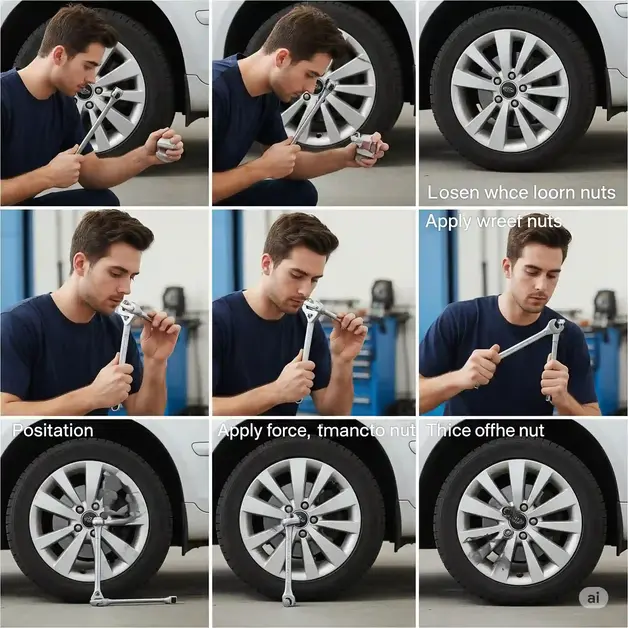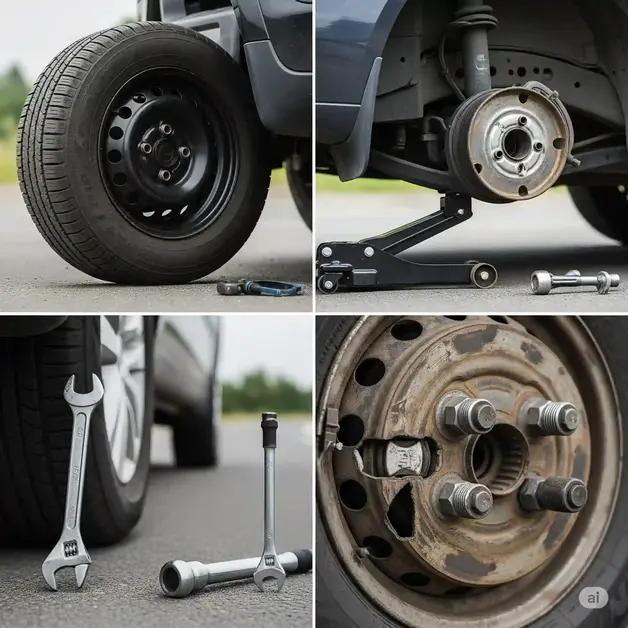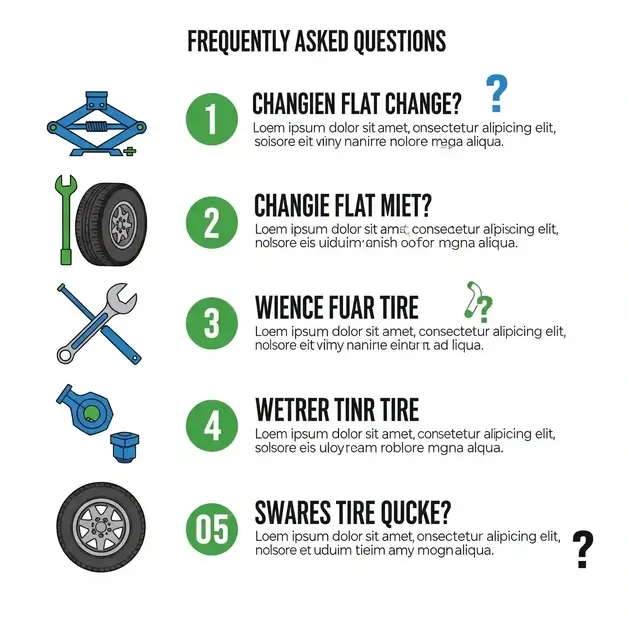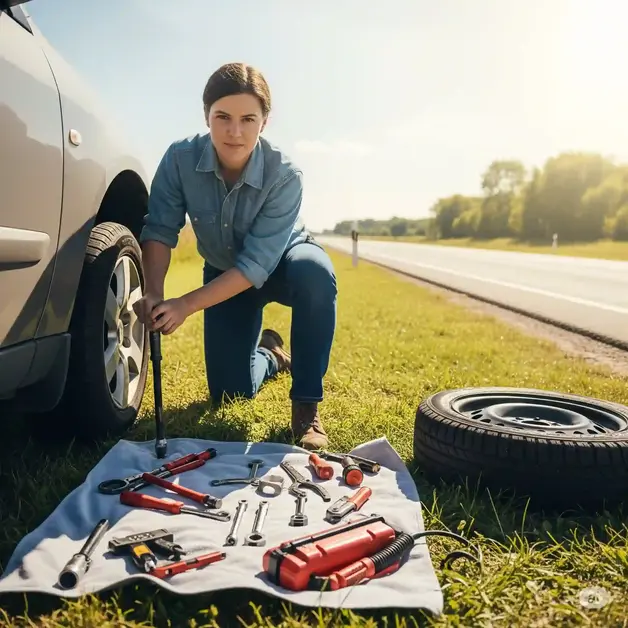I still remember the first time I had to figure out how to change a car tyre—I was stranded on a quiet backroad with zero phone signal and a boot full of groceries. At that moment, I realized just how empowering it is to know this one simple skill. Whether you’re dealing with a flat in your driveway or on the roadside, changing a flat tyre on a car isn’t as hard as it looks. With the right tools and a calm mindset, you can fix it faster than waiting for roadside assistance. In this guide, I’ll walk you through the steps I’ve used myself, with tips I wish I knew sooner—so next time you’re changing a tire, you’ll feel confident, not panicked. Let’s dive in and take the fear out of changing a flat tire together.
Why Knowing How to Change a Tyre Matters
You don’t think about how to change a car tyre—until you really need to. I learned this the hard way on a cold, rainy afternoon, miles from town. I had no signal, no friends nearby, and no time to waste. I sat there staring at the flat tyre, heart racing, feeling stuck. That moment taught me something important: knowing how to handle a flat isn’t just useful—it’s freedom on four wheels.
Flat tyres don’t give warnings. One minute, you’re cruising along listening to your favorite playlist. The next, your car dips, you hear that awful thud-thud-thud, and it hits you—you’ve got a flat. This is where basic tyre knowledge becomes your lifeline. If you know how to change a flat tyre on a car, you’re back on the road in 20–30 minutes. No panic, no expensive towing, no waiting.
What surprised me most? It’s not actually that hard. Most modern cars come with all the tools you need right in the boot. And once you learn the steps, changing a flat tire feels more like following a recipe than fixing a machine. You don’t need super strength or special skills—just a little confidence and a safe spot to pull over.
I always tell friends: even if you never plan to touch a jack in your life, learn the basics. Even knowing what the jack looks like, where your spare is, and what tyre pressure feels right can make all the difference. Especially when you’re driving solo or at night. Trust me, changing a tire doesn’t just fix your car—it teaches you to trust yourself more than you thought possible.
And hey, once you’ve done it once, you feel like a total boss. It’s one of those small life skills that pays off big—like learning to cook your favorite meal or resetting the Wi-Fi router when it crashes. You might not need it every day, but when you do, you’ll be glad you know exactly what to do.
When Do You Need to Change a Car Tyre?
Most of us don’t think about tire changes until it’s right there in front of us. But the truth is, knowing when to change a car tyre is just as important as knowing how. Sometimes it’s obvious—like a full-blown flat—but other times, the signs are sneaky and easy to miss if you’re not paying attention.
I once ignored a soft wobble in my steering wheel for a few days. It didn’t feel serious, just a slight shift when I hit 60 mph. Turns out, I had a slow leak. It wasn’t until I came back to the parking lot and saw one tyre half-deflated that I realized I should’ve trusted my gut. A flat tyre doesn’t always mean a dramatic blowout—sometimes it creeps up silently.
If you ever feel your car pulling to one side, or hear a faint thumping noise, stop and check. These can be signs that one tyre is either underinflated or already going flat. And if your tyre pressure warning light pops up? That’s your car gently begging you to take a look before things get worse. Even if you’re not sure what’s wrong, it’s safer to check now than to risk getting stranded later.
And here’s something not many people realize: when we say how to change a flat tyre on a car, we’re usually talking about changing the whole wheel. Swapping just the rubber part (the actual tyre) needs a special machine—what you and I do on the roadside is replacing the wheel with a spare. So, if you’re thinking, Do I need to change the tyre or the wheel?—you’re most likely changing the wheel.
Blowouts, slow leaks, and worn-out tread are all solid reasons to change a tyre. I keep an eye on tread depth—when it looks bald or uneven, that’s a warning. If you see any cuts, bubbles, or cracks on the sidewalls, it’s time. Better to switch it out than gamble on it holding up.
Bottom line? If your tire feels off, sounds weird, or looks wrong—trust your instincts. Knowing the early signs can save you from bigger problems later. And once you recognize them, changing a flat tire feels less like a panic moment and more like a quick fix you’ve totally got under control.
What You’ll Need Before You Start
Before you even think about loosening a wheel nut, make sure you’ve got the right gear ready. Trust me, there’s nothing worse than realizing you’re missing something halfway through changing a flat tyre on a car. I’ve been there—staring at my jack only to find I didn’t have the wheel brace. Lesson learned the hard way!
Basic Tools Required
Let’s start with the basics. You need a spare tyre—either a full-size or a space saver. Most cars keep it tucked away under the boot floor, and yep, it’s easy to forget it even exists until you need it. Next up is the jack. This is what lifts your car off the ground so you can actually get the wheel off. If your car didn’t come with one, I recommend a compact scissor jack like this one on Amazon—sturdy and easy to store in the boot.
Don’t forget your wheel brace or wrench. I’ve used a universal lug wrench like this one, and it works on most vehicles. This tool helps you loosen the nuts holding the wheel in place. And if your car has locking wheel nuts (those special nuts meant to stop theft), you’ll also need the locking wheel nut key. That little thing is easy to misplace, so keep it in your glove box—not buried under junk.
Your car owner’s manual is your secret weapon. It tells you exactly where to place the jack and what torque settings to use when tightening bolts later. Knowing this upfront can save you from damaging your car or worse—making the spare unsafe.
Optional but Helpful Tools
Now, let’s talk about the nice-to-haves that can make life easier. A reflective vest and a warning triangle are musts if you’re doing this on the side of a road, especially at night. They keep you visible to other drivers and reduce the chance of accidents.
A torch or headlamp helps you see clearly when changing a tyre in the dark. This LED headlamp from Amazon works great and keeps your hands free: Check it out here. A pair of gloves can protect your hands from grime or sharp edges—plus, it keeps your nails clean, which I appreciate more than I thought I would.
It’s also a good idea to carry a tyre pressure gauge—like this digital one—so you can check the spare before hitting the road. If you really want to do it right, grab a torque wrench like this budget-friendly option to tighten your wheel nuts properly. This ensures you tighten the wheel nuts just enough—not too loose, not too tight. If you’ve ever overtightened and struggled to remove them later, you’ll know why this matters.
Short answer: To change a flat tyre safely, you’ll need a spare wheel, jack, wrench, and possibly a few extras like gloves, a warning triangle, and a pressure gauge.
Having all this on hand means you’re prepared—not panicked—when a tyre lets you down. It turns a stressful moment into something manageable. And once you’ve done it once, you’ll feel like you’ve got your own roadside pit crew in the boot.
Step-by-Step: How to Change a Car Tyre (Roadside or Home)
Changing a flat tyre might sound like something only car-savvy people can do—but honestly, it’s easier than it seems. Think of it like making instant noodles: it looks tricky until you’ve done it once. The key is staying calm, using what you’ve got, and not rushing. Here’s how I change a tire, step by step—exactly how I’d show a friend.
Step 1 – Park Somewhere Safe
First things first—get your car off the road. If you’re on a busy street or highway, try to find a flat, solid spot away from traffic. Turn on your hazard lights so others can see you. One time I had a blowout near a bend, and I had to creep forward another 100 meters to find a safe shoulder. It’s okay to drive slowly on a flat for a short distance if it means staying safe.
Short answer: Always move to a safe, flat spot before changing your tyre—even if you have to drive a bit on the flat.
Step 2 – Apply Handbrake and Place Wheel Chocks
Once parked, pull the handbrake up as tight as it’ll go. If you’re driving an automatic, pop it into Park. For manuals, leave it in gear. Then block the wheels that are staying on the ground—bricks, large stones, or even a thick stick can help if you don’t have proper chocks. It might seem overkill, but one small roll could knock the jack over.
Short answer: Use the handbrake and block the wheels to stop the car from moving while you work.
Step 3 – Loosen the Wheel Nuts (Don’t Remove Yet)
Grab your wheel brace (or wrench) and break the wheel nuts loose before you lift the car. This is where many people mess up—including me the first time. I jacked up the car first, then tried loosening the nuts—and the wheel just spun in the air. Rookie move. So always crack the nuts while the tyre is still on the ground. Use your body weight if they’re stuck—step gently on the wrench if needed.
Short answer: Loosen wheel nuts while the tyre is still touching the ground—never after jacking up.
Step 4 – Use the Jack to Lift the Car
Now it’s jack time. Your car manual will show you the jack points—usually just behind the front tyres or in front of the rear tyres, under the frame. Place the jack on firm, level ground, and slowly raise the car until the flat tyre is off the ground. Don’t go too high—just enough to give you clearance.
I once tried jacking my car on gravel without a board underneath. It sank halfway down, and I had to start over. Now I always keep a small wooden plank in the boot just in case.
Short answer: Position the jack at the correct spot and raise the car just enough to remove the tyre.
Step 5 – Remove the Flat Tyre
With the car up, finish unscrewing the wheel nuts. Keep them in one spot—your hubcap works great as a tray so they don’t roll away. Carefully pull the flat tyre off. It might stick a bit if it’s been on for a while. Wiggle it side to side if needed. It should slide off the studs without too much force.
Short answer: Remove all nuts and gently pull the tyre straight off the wheel hub.
Step 6 – Mount the Spare Tyre
Lift the spare tyre and line it up with the wheel bolts. This part can feel awkward—especially with a full-size spare—but you’ll get the hang of it. Push it on until it sits flush against the hub, then screw the nuts back on by hand. Don’t tighten them fully yet—just enough to hold it in place.
Short answer: Mount the spare onto the bolts and hand-tighten the nuts to secure it.
Step 7 – Lower the Car and Tighten the Wheel Nuts in a Star Pattern
Now lower the car slowly until the tyre touches the ground fully. Then tighten the wheel nuts using a star or crisscross pattern. This keeps the pressure even, so the wheel sits flat. I didn’t know this trick the first time—and my wheel wobbles because I tightened in a circle. Lesson learned.
If you have a torque wrench, now’s the time to use it. If not, tighten firmly but don’t go overboard—you don’t want to strip the threads or make it impossible to remove later.
Short answer: Lower the car fully, then tighten the nuts in a crisscross pattern for even pressure.
Step 8 – Check Tyre Pressure and Store Tools
Before driving off, check the spare tyre pressure if you can. Most spares (especially space savers) have a max limit written on them—usually around 60 PSI. If you don’t have a gauge, at least give it a visual check and a firm press. Then pack up all your tools, the flat tyre, and any safety gear you used.
I always double-check that I didn’t leave anything behind. Once, I left my torch on the side of the road. By the time I noticed, it was long gone.
Short answer: Make sure the spare tyre has enough air, clean up your tools, and double-check nothing is left behind.
Changing a tyre might seem stressful at the moment, but with the right steps, it becomes second nature. It’s like making your bed or frying an egg—you might fumble the first time, but after that, you’re golden. Take a breath, follow the steps, and trust that you’ve got this.
Safety Tips You Shouldn’t Skip
When it comes to changing a flat tyre, safety is everything. Seriously—it’s not just about getting the job done, it’s about how you do it without putting yourself (or others) at risk. I learned this the hard way when I tried to change a tire in sandals on uneven ground. Spoiler alert: I slipped, nearly dropped the jack, and gave myself a nasty scar. So, take these tips seriously—they’re the difference between a quick fix and a roadside nightmare.
Want to stay extra safe at night? A reflective vest like this one and a foldable warning triangle (Amazon link) are compact, affordable, and can make a huge difference in visibility.
Never Work on a Slope or Soft Ground
Before you even grab your tools, check the ground. Is it flat? Is it firm? If it’s sloped or soggy, don’t start. I once saw a guy try to jack up his car on a muddy shoulder after a rainstorm. The jack sank, and the whole car leaned dangerously. If the surface isn’t stable, your jack won’t be either—and that’s a recipe for disaster.
Short answer: Always change your tire on solid, flat ground to keep your jack stable and prevent the car from shifting.
Always Turn On Hazard Lights
Your hazard lights aren’t just for show. They’re your loud, blinking way of telling other drivers, “Hey, something’s up over here.” Whether it’s day or night, flip them on the moment you stop. Especially if you’re near traffic. It gives everyone around you a heads-up and helps keep you visible from a distance.
Short answer: Turn on your hazards right away to warn oncoming traffic and stay visible while working.
Keep Your Body Away from Under the Vehicle
This one’s a golden rule: never crawl under the car when it’s only supported by a jack. Not even halfway. Jacks can fail, especially the flimsy scissor types that come with most cars. If you drop a nut under there, grab a stick or move the car afterward—but don’t risk reaching under it. Your safety isn’t worth a wheel nut.
Short answer: Never go under the car while it’s jacked up—it’s unstable and dangerous without proper support.
Avoid Changing Tyres on Highways—Call for Help
If your tyre blows out on a highway, don’t play hero. I’ve driven long enough to know that fast-moving cars and tight shoulders make for a scary mix. If you can’t get well away from traffic, it’s better to call roadside assistance than risk stepping out near 70-mph lanes. Even the best spare isn’t worth your life.
Short answer: On highways or unsafe spots, stay inside your car and call for help—it’s the safest move you can make.
Changing a flat tyre is empowering—but only when done right. I always say: treat it like making fire. It’s useful, but if you’re careless, you’ll get burned. With just a few mindful choices, you can keep yourself safe while taking control of the situation. And once you’ve done it the safe way, you’ll never go back to winging it.
Common Mistakes I’ve Seen (and Made)
Changing a car tyre might seem simple once you know how, but trust me—there are plenty of easy mistakes that can trip you up. I’ve made a few myself, and I’ve seen others do the same. The good news? Most of these are totally avoidable once you know what to watch for. So here’s my honest list of tyre-change blunders, shared like I would with a friend over tea.
Keep a small kit of essentials in your boot so you’re never caught off guard. Mine includes a pair of mechanic gloves like these grippy ones, a flashlight, and all my tools in one storage box.
Forgetting to Check Spare Tyre Pressure
This one gets everyone at least once. You open the boot, proud of yourself for being prepared—only to find the spare is as flat as the tyre you’re replacing. It’s such a frustrating moment. I learned the hard way when I installed my space saver, only to feel the car wobble minutes later. The pressure was almost zero.
Short answer: Always check your spare tyre pressure every few months so it’s ready when you need it.
Mixing Up Jacking Points
Every car has specific spots where the jack should go. Miss those, and you risk bending your car’s underbody—or worse, having the jack slip. I once placed the jack just slightly off the reinforced seam, and when I started lifting, it made a sickening crunch. It still haunts me.
Short answer: Use your owner’s manual to find the right jacking points before lifting the car.
Overtightening or Under-tightening the Bolts
I get it—when you’re stressed, it’s easy to either crank the bolts down too hard or barely tighten them at all. Both are risky. Too tight, and you might strip the threads. Too loose, and the wheel would shake or even come off. I now tighten in a crisscross pattern, using my body weight gently—not brute force.
Short answer: Tighten wheel nuts evenly, using a star pattern, and avoid over tightening or leaving them too loose.
Leaving Tools (or the Flat Tyre) on the Road
It sounds silly, but when your mind’s racing, it’s easy to forget things. I once left my wheel wrench behind on the shoulder of a rural road. Didn’t realize until I needed it again a month later—gone. Now I always lay everything out in one spot and double-check before driving off.
Short answer: Keep your tools together and always do a final sweep before packing up and hitting the road.
It’s normal to mess up a little the first time. We all do. But each mistake teaches you something—and the next time gets easier. The key is slowing down, staying mindful, and not letting panic take the wheel. That way, your flat tyre becomes just another story, not a disaster.
How Far Can You Drive on a Spare Tyre?
Let’s be honest—once you’ve swapped out your flat for that little doughnut of a spare tyre, your first thought is probably, “How far can I actually drive on this thing?” I’ve been there, sweating through traffic with my hazards on, hoping the spare wouldn’t give up before I reached the nearest garage.
Short answer: Most space saver spare tyres are only meant to get you about 50 miles at no more than 50 mph.
Space Saver Limits: 50 Miles at 50 MPH
If your spare tyre looks skinny and kind of sad next to your regular tyres, that’s a space saver. It’s not made for long distances or high speeds. I once tried pushing mine to 70 mph on the highway—not smart. The car felt wobbly, and braking took longer. I got off at the next exit and slowed down real quick.
Stick to under 50 miles, and don’t go faster than 50 mph. That’s what they’re designed for, and anything beyond that risks damaging your car—or worse.
Full-Size Spares vs Temporary Spares
Not all spare tyres are created equal. Some cars come with a full-size spare—basically the same as your other tyres. If that’s what you’ve got, great! You can drive it like normal. Just make sure the tread and pressure are good.
But if it’s a space saver or compact temporary spare, you’ll know right away. It’ll be thinner, lighter, and labeled with warnings. And it’ll feel different when you drive. Steering might feel twitchy, and braking takes more focus.
Short answer: Full-size spares can be driven like a normal tyre; space savers can’t.
What I Did When I Had to Drive on a Spare Longer Than I Should Have
I’ll confess—once, I drove over 100 miles on a space saver. I was out of town, no tyre shops were open, and I had no choice. I kept my speed under 40 mph, avoided hard turns, and prayed at every red light. The tyre held up, but by the end, it was not happy. It squealed during turns and felt like it was about to pop.
So while it might be possible to push a spare tyre farther than 50 miles, I wouldn’t recommend it. The risk of a second breakdown—or damaging your suspension—is just too high.
If you’ve just put on a spare, think of it like a crutch. It’ll help you hobble to safety, but it’s no long-term fix. Your next stop should be a tyre shop or garage. And if you’re reading this while sitting on your spare? Take a breath—you’re doing great. Just don’t wait too long to swap it out for the real deal.
When to Call for Help Instead
Sometimes, no matter how prepared you are, it’s just not the right time—or place—to change a tire on your own. I’ve been there, standing on the shoulder of a busy motorway with trucks flying by and my hands shaking more than I’d like to admit. In moments like that, calling for help isn’t giving up—it’s choosing safety first.
Short answer: If your location or situation feels unsafe or unmanageable, it’s best to call roadside assistance or a recovery service.
No Tools or Missing Wheel Nut Key
It’s easy to assume your car has everything, but I learned the hard way that’s not always true. Once, I opened my boot only to find the jack was missing—and I’d lent my wheel brace to a friend months ago. Another time, I had a locking nut on the wheel but no key. Without these, changing the tyre just isn’t possible.
If you’re missing essential tools, don’t try to improvise. Call for help instead and avoid damaging the wheel or hurting yourself.
Dangerous Location (e.g., Motorway)
Let me be very clear: changing a tyre on a motorway or high-speed road is incredibly risky. Even with hazard lights on, cars whizz by fast—and some drivers just don’t pay attention. I once pulled over on a dual carriageway and, within minutes, realised how unsafe it was. I got back in the car, called breakdown service, and waited behind the barrier.
If you’re on a motorway or a blind bend, it’s simply not worth the risk. Call a tow or roadside service and wait in a safe place.
Damaged Wheel or Lug Nuts
Sometimes, the flat tire isn’t the only problem. If the rim is bent or the lug nuts are rusted solid (or worse—stripped), your standard tools won’t do much. I’ve had one lug nut round off so badly it looked like a soft cube. I ended up needing a mechanic with a proper extraction tool.
If anything looks bent, broken, or refuses to budge, get help. Forcing it can make things worse or injure you.
TPMS Warning Lights Still Flashing
Modern cars often have Tyre Pressure Monitoring Systems (TPMS), and if the warning light stays on even after fitting the spare, it might signal deeper issues—like uneven tyre pressure or system malfunction. It once happened to me after swapping tyres, and the car felt oddly unstable. I thought I’d done something wrong.
If your dashboard won’t clear or the ride feels off, play it safe and get it checked. A second opinion can save your suspension—and your peace of mind.
You don’t have to be a hero every time your car lets you down. Some situations just call for a phone and a bit of patience. Trust your instincts—if something feels off, it probably is. There’s no shame in calling for backup when the smarter move is safety.
FAQs About Changing a Flat Tyre
Q: How long does it take to change a car tyre?
Changing a car tyre takes about 15 to 30 minutes, depending on your tools, location, and experience.
Q: Is it safe to change a tire on the side of the road?
Yes, but only if the area is flat, safe, and away from traffic. If you’re on a highway, call for help instead.
Q: Can I drive with a flat tyre to a safer location?
No, driving on a flat can damage the rim or suspension. If needed, drive only a few meters slowly to get to safety.
Q: Do I need to torque the wheel nuts?
Yes, use a torque wrench if you have one. Proper torque ensures your wheel is secure and prevents future issues.
Q: What if my car has a tyre pressure sensor (TPMS)?
After changing the tyre, your TPMS may stay on. Check the pressure, reset the system if needed, or visit a garage.
Q: What’s the difference between changing a tyre and changing a wheel?
Changing a tyre means removing just the rubber part. Changing a wheel means replacing the whole wheel and tyre together.
Q: Can I reuse a spare tyre more than once?
You can, but only if it’s in good condition. Always check tread, cracks, and pressure before using it again.
Q: What tyre pressure should I use for the spare?
Check your car manual or the tyre label inside the door. Most spares need 60 PSI, but it depends on the type.
Q: Is it okay to use a space saver tyre for long trips?
No, space saver tyres are for short distances only—about 50 miles max. They’re not made for long drives or high speeds.
Q: Can I change a flat tire at night?
Yes, but only with proper lighting, reflective gear, and safety tools. Avoid dark, unsafe areas and always turn on your hazard lights.
Final Thoughts – You’ve Got This!
If you’re someone who values self-reliance and likes being prepared for anything on the road, learning how to change a car tyre is a skill worth mastering. But if you prefer leaving car stuff to the pros or get anxious in high-pressure situations, it’s totally okay to call for help instead. Personally, changing my own tyre gave me a weird kind of pride—like I’d leveled up as a driver. It’s not always easy the first time, but trust me, you’ve got this. And once you do it, you’ll never feel stuck again. Want to build your own emergency tyre kit? I’ve listed all my go-to tools here on Amazon—they’ve saved me more than once, and they’ll save you time (and stress) too.


1 thought on “How to Change a Car Tyre: My Step-by-Step Guide”